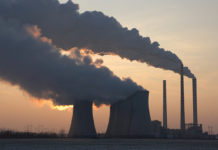
Politicians, who promise to stem the seemingly inevitable growth and pervasive presence of government, typically follow one of these three imperfect equations:
1) they profess a certain position or philosophy (for political expediency) but don’t really believe it;
2) they genuinely believe a certain position or philosophy but lack the political courage to profess it openly; or
3) they genuinely believe a certain position or philosophy and have the political courage to profess it, but lack the ability to translate that belief into any meaningful action. None of these, ultimately, is beneficial to the citizens they represent. In short, they are really nothing more than three different flavors of fraud. Not surprisingly, after enough exposure to this frustrating reality, most citizens wax cynical, and the whole subject of politics is relegated to everyone’s dumpster of worthless but necessary evils.
Now, take that observation and apply it to the subject of energy policy in the United States — specifically, policies relating to the oil and gas industry. Looking back over the past 50 years, these familiar themes emerge: Democrat presidents and members of Congress pursue policies designed to regulate, disfavor and finally eliminate the ability to explore for, develop and produce the oil and natural gas resources that are so abundant in this country; while Republican presidents and members of Congress rail against Democratic policies, profess their intentions to undo the damage done and declare their unwavering allegiance to policies designed to throw open the doors of access to the development of these natural resources.
The end of the story, however, is always the same. Democrats succeed in their mission and incrementally move the nation in the direction of making it more difficult to realize the inherent advantages of our oil and natural gas reserves. Republicans, on the other hand, routinely disappoint and, with rare exceptions, fail to undo anything — but never stop passionately declaring their preferences.
Enter President Donald Trump; Republican, yes — but not in the mold of any of the three personality types described above. In fact, arguably, his victory last November was most likely for the very reason that he was viewed by voters as a clear exception to what had become a painful but chronic reality for those searching in futility for any exit ramp off the highway to self-inflicted decline, including self-imposed energy poverty.
Trump certainly caught the attention of those voters who had been wandering in the wilderness during the eight years under President Obama. He was outrageously blunt, to the delight of the crowds that gathered to determine whether he might be worth their vote. But voters had been fooled before — oh, so many times before — by previous candidates willing to whip a crowd into a frenzy, only for those faithful followers to learn later that it was all for show.
Enough voters in enough states gave Trump an electoral victory in November, and so the wait and see began. Donald Trump was inaugurated as the 45th president of the United States on January 20, and his work to prove his word began that day. The White House website had prominently featured a page dedicated to fighting climate change during the Obama administration, which was immediately taken down and replaced with a page titled “An America First Energy Plan.” That plan highlighted the objectives of the new Trump administration, which include eliminating unnecessary regulations and policies, reviving the domestic coal industry and discarding the previous administration’s obsession with climate change, in favor of pursuing a policy of promoting U.S. energy and protecting the U.S. economy.
President Trump then unleashed a whirlwind of executive orders, including many that were primarily intended to undo previous executive orders issued by President Obama, many of which burdened the oil and gas industry. After eight years of Obama cruelly toying with TransCanada’s Keystone XL Pipeline and finally rejecting its permit, Trump issued an executive order on January 24 approving the pipeline. After Obama similarly acted to unilaterally block Energy Transfer’s Dakota Access Pipeline, Trump removed the Obama obstacles and also approved that pipeline. Trump made it clear that the U.S., once again, is open for business.
On February 28, Trump issued an executive order relating to what has become the bane of many private-property owners across the country: the federal government’s overreach based on its expansive definition of the phrase “waters of the United States.” What had originally meant navigable waterways in the context of interstate commerce had been allowed to mushroom into covering every ditch, pothole and swale on a person’s property, such that the EPA and the Army Corps of Engineers could prevent you from using your property and then fine you into bankruptcy if you did. Trump’s executive order directs the EPA to review its current rule and bring it back into line with the definition handed down by U.S. Supreme Court Justice Antonin Scalia in a decision that has been largely ignored by the federal government up until now.
On March 28, Trump signed an executive order to dismantle Obama’s crowning environmental achievement, known as the Clean Power Plan, which would have had the effect of shutting down coal-fired power plants and unnecessarily increasing energy costs across the country — all for the stated goal of slowing the increase in the global temperature by only 0.023 degrees Fahrenheit by the end of this century. On April 26, Trump issued an executive order designed to review the millions of acres in Western states that Obama declared to be national monuments on his way out the door. Instead, Trump has instructed the Department of the Interior to develop plans to open up federal lands for natural-resource development. That order also cancels Obama’s previous ban on new offshore drilling leases in the Atlantic, Pacific and Arctic oceans, as well as the Gulf of Mexico.
Trump’s executive orders have also stopped or rescinded previous Obama edicts relating to burdensome regulations on methane emissions at oilfield locations, as well as a massive, comprehensive “information request” served on the oil and gas industry last year, which would have undoubtedly been used eventually to regulate, tax and eliminate oilfield operations with confirmed methane emissions.
In the short time he has been in office, Trump’s actions speak volumes. During his economically impressive administration, President Calvin Coolidge famously quipped that “the business of America is business.” With the speed and sweep of actions taken in the first 120 days in office, it’s abundantly clear that President Trump “means business.” What remains to be seen is to what extent these actions will have any lasting effect on the direction of U.S. energy policy. And, in case there’s any question, Russia won’t like any of this.
About the author: Bill Keffer is a contributing columnist to SHALE Magazine. He teaches at the Texas Tech University School of Law and continues to consult. He served in the Texas Legislature from 2003 to 2007.
Photo source: andykatz/bigstock.com














